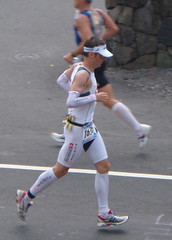
 |
| Recognize anyone? |
Their pool based water work is often the key to a quick return. For those not injured, the swimming pool can also be used as a great training tool in addition to your other workouts. Look closer at the 2nd picture and you may recognize some of our badminton players who have been to the last 2 Olympics- Ronald Susilo, Kendrick Lee, Xing Aiying and Li li etc. Our Singapore badminton team went to the pool once a week at least during periods when they were training at their hardest so they can train in a setting with little or no impact to minimize injuries with yours truly leading the session in the water with them.
Now, this is not a typical swim training session like you might think. As most land based athletes are not good swimmers, I often use aqua running techniques (or deep water running) to produce a valuable training effect for them. It would take a far longer time to get them to be of a good swimming standard to get the same effect from swimming and since time is a precious commodity in sports rehabilitation hence the use of deep water running. Moreover, most of these athletes or patients are involved in some land based or running sports, so swimming offers less transferable benefits or movements that are similar to their land based activities.
Done right it is a full body workout involving the legs, arms, shoulders and core muscles.It is also a good alternative to pounding the streets day after day. A study comparing a group doing deep water running versus another group road running found both training programmes produced similiar improvements in V02 max levels.
Water is about 773 times more resistant than air, so it can strengthen all key running muscles. Water is also isokinetic, meaning the water resists you as much as you resist it. The harder you move your arms or legs through the water, the more drag force or resistance you encounter. What's more challenging? Doing the workout without a flotation device or belt. I often get my athletes to do the entire session without one to push them harder.
The pool is a very good and versatile environment for rehabilitation work and training for athletes and patients. By including this session, you can allow for injured athletes or patients to recover quicker and allow others to undertake higher intensity water based training. It will not do the aqua training technique justice for me to describe how you do it in just a few short sentences, please contact us know if you need more advice on this. Physio Solutions conducts deep water running classes, give us a ring to find out more.
References
Davidson, K (2000). Deep Water Running Training Improve V02 max in Untrained Women. Journal of Strength and Conditioning Research. 14 (2) 191-195
Dowzer, CN and Reilly, T (1998). Deep Water Running. Sports Exercise and Injury. 4: 56-61







